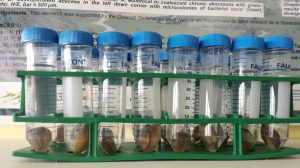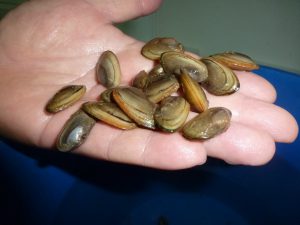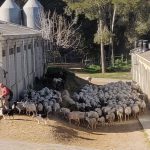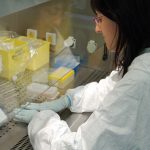Clearance and persistence of Escherichia coli in the freshwater mussel Unio mancus
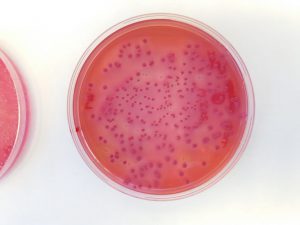
One Health is a collaborative, multi-sectoral and transdisciplinary approach with the aim of achieving optimal health outcomes by recognising the interlinkage between humans, animals, plants, and their shared environment. Although the role of the environment is still under-recognised in public health research, it is well known that the integration of environmental factors into the One Health strategy leads to a holistic understanding of public health. Studying the ecology of environmental pathogens can help identify health risks, potentially preventing widespread exposure to these threats.
The overuse of antibiotics has led to the appearance of resistant bacteria, mainly from the Enterobacterales group, with high pathogenic/zoonotic potential that can cause public health problems. Considering that more than 70% of emerging infectious diseases are zoonotic and most of them originate from wild species.
Inland waters, such as rivers, lakes, and marshes, are hotspots for zoonotic agents originating from human activities. Despite this, there is still insufficient knowledge of dispersion and mitigation in aquatic ecosystems. The need to assess the potential of wild animals as sentinel or indicator species for the detection and surveillance of these pathogens is becoming increasingly apparent.
Freshwater mussels (naiads) provide a valuable ecosystem service to the aquatic environment by filtering a large amount of water during their feeding process. These organisms consume bacteria, phytoplankton, detritus, and organic matter. Through these feeding habits, naiads translocate nutrients throughout the water column, providing resources to other organisms and helping to maintain the quality of the aquatic environment.
Several studies investigating the kinetics of bioaccumulation and elimination of micro-organisms by bivalves have determined their shedding capacity for bacterial, viral and protozoan pathogens, such as Escherichia coli and Clostridium perfringens, avian influenza virus, Norwalk-like virus and Toxoplasma gondii, among others. For example, the invasive foreign species Dreissena polymorpha is considered to have a high potential to reduce E. coli in freshwater systems.
In this work we have studied the ability of the naiad Unio mancus to remove E. coli from water, observed the viability of this bacteria to remain active in the soft tissue of this animal and calculated the retention time under experimental conditions to evaluate the potential of this sentinel species in the detection of enterobacteria in freshwater environment.
U. mancus (Phylum Mollusca; Class Bivalvia) inhabits inland freshwaters of the Mediterranean in north-eastern Spain, France, and Italy. It is classified as Near Threatened in the Red List of the International Union for Conservation of Nature (IUCN) and as Vulnerable in Catálogo Nacional de Especies Amenazadas. The specimens used in this experiment came from the captive breeding of the Laboratori de Cria de Nàiades de l’Estany de Banyoles (Consorci de l’Estany).
36 U. mancus specimens were exposed for one hour to an inoculum of cephalosporin resistant E. coli E. coli blaCTX-M-14, from the IRTA-CRESA’s cryobank). At different times (one hour, 8 h and then every 24 h – T24, T48, etc.-) the presence of E. coli was analysed. The water and food provided during the maintenance phase of the specimens were also analysed. Mussels of different sizes were selected at each time to check the possible effect of the size on the rate of elimination and, consequently, bacterial elimination. Each animal was necropsied. The soft tissue was homogenised, and bacterial counts were made to detect the targeted E. coli.
The filtering capacity of the mussels was evaluated by observing that the E. coli elimination rate was 6.8 × 104 ± 1.6 × 104 CFU/ml, corresponding to 45.1 ± 10.7% of the inoculated bacteria. Clearance and filtration rates were also evaluated. The removal rate refers to a volume of water cleaned of suspended particles, while the filtration rate is a pumping rate or volume. A removal rate of 18 ± 4 ml/h was calculated based on bacterial removal. The estimated filtration rate was 76.0 ml/h.
Regarding the persistence of E. coli in soft tissue, the clearance phase ended 7 days after exposure. Analysis of control mussels (time 0 h), water and microalgae feed showed that they were negative for the presence of E. coli. A high concentration of E. coli was observed in the soft tissue of the specimens the first two sampling times, decreasing drastically to a few units per ml after 24 h. The presence of E. coli was detected in tissue up to 4 days after exposure, and in culture water up to 48 h, but not later than 4 days after exposure.
The ability of the naiad U. mancus to eliminate and accumulate viable E. coli has been demonstrated for the first time, confirming its significant functionality in providing a demonstrable ecosystem service through the elimination of potential pathogens in freshwater aquatic ecosystems. In addition, basic knowledge has been established to develop non-invasive molecular techniques that allow the use of U. mancus as a sentinel to study the presence of Enterobacteriaceae in freshwater environments. The data generated from this study aims to improve the value of this endangered species, and raise awareness among authorities to invest in its conservation and reinforce the One Health strategy.
This study has been funded by Diputació de Girona and Obra Social de la Caixa within the framework of the collaboration project between Diputació de Girona and la Caixa in the field of natural areas 2017. It was recently published in the scientific journal Scientific Reports:
Clearance and persistence of Escherichia coli in the freshwater mussel Unio mancus. M. Campos, L. Lobato‑Bailón, R. Merciai, O. Cabezón, I. Torres‑Blas, R. Araujo & L. Migura‑Garcia. 2022. https://doi.org/10.1038/s41598-022-16491-x
About the author of this post:
Miquel Campos, Oscar Cabezon, Lourdes Migura
Coordinador del Laboratori de cria de nàiades de l’Estany de Banyoles -Consorci de l’Estany (mcampos@consorcidelestany.org)
Investigador, Wildlife Conservation Medicine (UAB) (oscar.cabezon@uab.cat)
Investigadora IRTA-CReSA (lourdes.migura@irta.cat)


